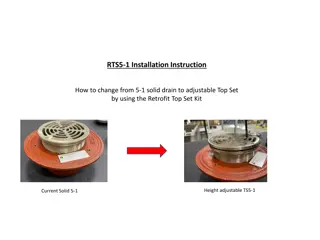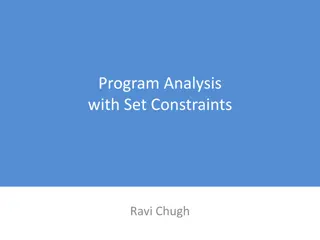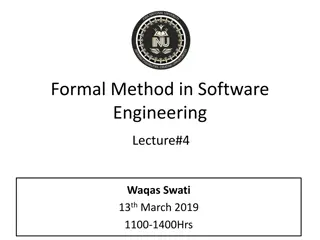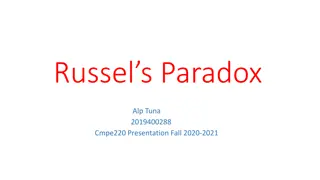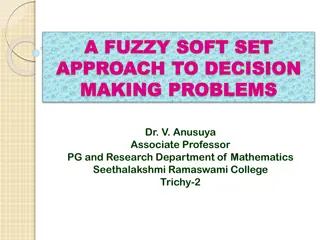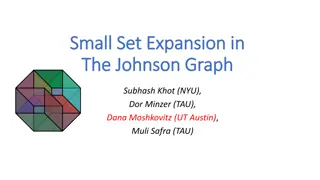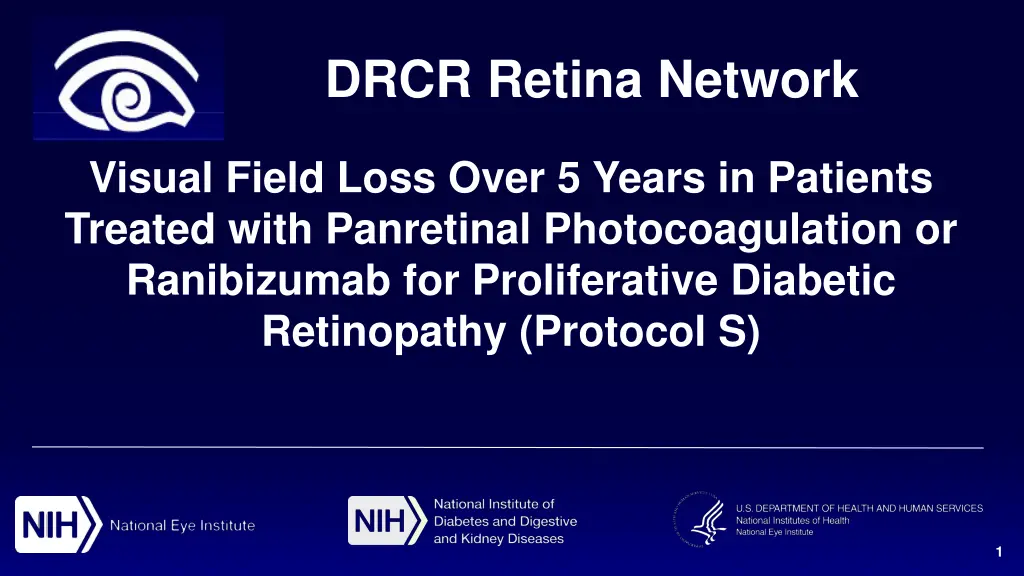
Visual Field Changes in Patients with Proliferative Diabetic Retinopathy
Explore visual field changes over 5 years in patients treated with panretinal photocoagulation or ranibizumab for proliferative diabetic retinopathy. Findings show that mean visual acuity did not differ between treatment groups, but visual field loss worsened in the panretinal photocoagulation group at the two-year mark. Peripheral field preservation was noted as an advantage of anti-VEGF monotherapy.
Download Presentation

Please find below an Image/Link to download the presentation.
The content on the website is provided AS IS for your information and personal use only. It may not be sold, licensed, or shared on other websites without obtaining consent from the author. If you encounter any issues during the download, it is possible that the publisher has removed the file from their server.
You are allowed to download the files provided on this website for personal or commercial use, subject to the condition that they are used lawfully. All files are the property of their respective owners.
The content on the website is provided AS IS for your information and personal use only. It may not be sold, licensed, or shared on other websites without obtaining consent from the author.
E N D
Presentation Transcript
DRCR Retina Network Visual Field Loss Over 5 Years in Patients Treated with Panretinal Photocoagulation or Ranibizumab for Proliferative Diabetic Retinopathy (Protocol S) 1
Visual Fields in DRCR Network Protocol S Protocol S: PRP vs anti-VEGF (0.5-mg ranibizumab) for proliferative diabetic retinopathy Primary outcome: No differences in mean visual acuity between groups at 2 and 5 years after randomization Visual field loss, on average, worsened only in the PRP group at two years Preservation of peripheral field considered advantage of anti-VEGF monotherapy 2
Mean Change in Cumulative VF Total Point Score (HFA 30-2 + 60-4) - Overall Cohort at 2-Years 200 Mean Change in Cumulative Total Point Ranibizumab PRP 0 -23 -200 Score (dB) -400 -422 -600 2-Year Adjusted Mean Difference: 372 dB 95% Confidence Interval (213, 531), P < .001 -800 0 52 104 N = 58 N = 65 N = 81 N = 86 N = 67 N = 57 Visit Week 3 Outlying values were truncated to 3 SD from the mean
Objective Preplanned Secondary Analysis To explore Humphrey visual field changes through 5 years in eyes receiving anti-VEGF or PRP for PDR 4
Methods A subset of subjects enrolled in Protocol S underwent standard automated perimetry (SAP) using the Humphrey Field Analyzer (HFA) Both HFA 30-2 (central) and 60-4 (peripheral) test patterns were required on each study eye using a size V target with FastPac testing strategy 5
Visual Field Measure Total point score Total point score = sum of thresholds (dB) over all 134 positive numbers Higher values indicate response to dimmer light and greater retinal sensitivity Difference of 134 points is 1 dB difference in mean deviation 6
VF Data Available (among 203 eyes assigned to PRP Group and 191 eyes assigned to Ranibizumab Group) Baseline Ranibizumab group eyes 5 Years 34% of Baseline VF 71% of Evaluable VF 114 VF Testing at Baseline 81 Meet Quality Criteria 41 Eyes Tested of 58 Examined PRP group eyes 120 VF Testing at Baseline 86 Meet Quality Criteria 38 Eyes Tested of 61 Examined 20% of Enrolled Eyes 59% of Enrolled Eyes 42% of Enrolled Eyes 7
Baseline Visual Field Testing Ranibizumab Group (N = 81) 2145 -5.7 1220 -8.7 PRP Group (N = 86) 2195 -5.4 1292 -7.7 Among all eyes with sufficient quality baseline VF HFA 30-2 cumulative score (dB), mean Mean deviation (dB), mean HFA 60-4 cumulative score (dB), mean Mean deviation (dB), mean HFA 30-2 + 60-4 combined cumulative score (dB), mean Mean deviation (dB), mean 3365 3487 -7.0 -6.4 8
Mean Change in Cumulative Visual Field Total Point Score (HFA 30-2 + 60-4) - Overall Cohort 200 Mean Change in Cumulative Total Point Ranibizumab PRP 0 -23 -200 Score (dB) -400 -422 -600 2-Year Adjusted Mean Difference: 372 dB 95% Confidence Interval (213, 531), P < .001 -800 0 52 N = 65 104 N = 58 156 208 260 N = 81 N = 86 N = 67 N = 57 Visit Week 9 Outlying values were truncated to 3 SD from the mean
Mean Change in Cumulative Visual Field Total Point Score (HFA 30-2 + 60-4) - Overall Cohort 200 Mean Change in Cumulative Total Point Ranibizumab PRP 0 -200 -330 Score (dB) -400 -527 -600 5-Year Adjusted Mean Difference: 208 dB 95% Confidence Interval (9, 408), P = .04 -800 0 52 N = 65 104 N = 58 156 N = 43 208 N = 41 260 N = 41 N = 81 N = 86 N = 42 N = 67 N = 38 N = 39 N = 57 Visit Week 10 Outlying values were truncated to 3 SD from the mean
Is the Ranibizumab Groups Decline Associated with PRP (including endolaser) during Follow-up? Excluding 12 eyes in the Ranibizumab group after receiving PRP Overall 200 Mean Change in Cumulative Total Ranibizumab PRP Ranibizumab PRP 0 -201 Point Score (dB) -200 -330 -400 -527 -527 -600 -800 0 52 104 156 208 260 0 52 104 156 208 260 Visit Week 11
Statistical Modelling of VF Change Longitudinal, mixed-effects linear regression model including baseline point score, randomization stratification factors*, years after baseline, and time-dependent variables for PRP and endolaser applications and number of ranibizumab injections in the previous year. Status of laser treatment changed after different types of laser treatments were applied to an eye * Including baseline central subfield thickness and an indicator variable for presence of both eyes in the study 12
Estimates of Mean Change in Total Point Score Associated with Ranibizumab Injections Mean Change in Total Point Score* 95% CI of Mean Change P Value No. of Ranibizumab Injections Within the Last Year -9 (-22, +3) .15 * Model includes: years after baseline as a categorical variable, baseline total point score, number of study eyes per participant, baseline central subfield thickness on OCT, number of ranibizumab injections within the last year, first PRP, each additional PRP, and endolaser. 13
Estimates of Mean Change in Total Point Score Associated with Laser Treatment Mean Change in Total Point Score* 95% CI of Mean Change P Value First PRP -208 (-304, -112) <.001 Each Additional PRP Session -77 (-133, -21) .008 Endolaser -325 (-439, -211) <.001 * Model includes: years after baseline as a categorical variable, baseline total point score, number of study eyes per participant, baseline central subfield thickness on OCT, number of ranibizumab injections within the last year, first PRP, each additional PRP, and endolaser. 14
Change in Visual Field Over Time The number of eyes with VF data available and the degree of missing data preclude definitive conclusions about VF changes in eyes treated for PDR Visual field loss, on average, worsened only in the PRP group at two years, but worsened in both the PRP and ranibizumab groups from years 2-5 After removing the VF data for eyes in the ranibizumab group following PRP Average loss of VF sensitivity was less than the full ranibizumab group Decline in VF sensitivity remained between 2-5 years 15
Change in Visual Field Over Time There was substantial loss of VF associated with application of laser treatment for PDR The amount of loss depended on the type of laser treatment Compared with an initial PRP session, additional PRP sessions on average were associated with less VF loss, and endolaser application during vitrectomy was associated with more VF loss 16
Speculations: Progression of DR is impacting VF Diabetic retinal neurodegeneration progresses with duration of diabetes and may precede signs of DR Supported by mean deviation of -6.5 dB at baseline in both groups Supported by CLARITY study results (aflibercept vs. PRP for PDR in the UK) CLARITY study showed the mean total areas of retinal non-perfusion in both treatment groups increased by 1 year after initiation of treatment 17
Speculations: Could Ranibizumab Be Harmful to Peripheral Visual Field? Greater cumulative number of ranibizumab injections over time may have caused loss of visual field sensitivity VEGF is neuroprotective for retinal cells in a variety of animal models and suppression could theoretically cause visual field loss 18
Speculations: Could Ranibizumab Have Been Protective? Ranibizumab may have protected eyes with PDR from visual field loss during years 1 and 2 of the study As the number of injections decreased from 7 in year 1, to 4 in year 2, to 3 in later years, the visual field loss that is part of the natural history of PDR became apparent 19
Summary Eyes enrolled in Protocol S had substantial VF loss at baseline. Application of scatter laser treatment, particularly endolaser during vitrectomy, was associated with large losses in VF. 20
Summary The VF loss in the ranibizumab group, which occurred predominantly after 2 years of follow-up, was explained only in part by laser treatments during follow-up. More precise conclusions are precluded by the limitations of the available data. Further clinical research is warranted to clarify the situation. 21










